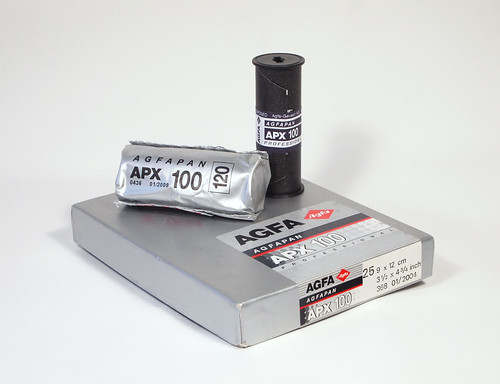 |
| Agfa Agfapan APX 100 in sheet film (9x12cm) and medium format |
Among the currently available range of black and white films, there are two films named
AgfaPhoto APX, in 100 and 400 speeds. This film is sold by
Lupus Imaging, and, it seems, is most likely made by Harman, similar to the Rollei RPX films, and (but perhaps not quite the same as) Harman's Kentmere films. These films from Lupus trade on the name of Agfa's discontinued
Agfapan APX 100; this post is about the
original Agfapan APX 100 and it is not a comparison to the new APX 100; the new APX 100 films are
not the same emulsion or a new version of Agfa's original: apparently
Adox Silvermax is close to the original APX 100 recipe.
I first used Agfapan APX 100 in 35mm when it was sold under the name of
Rollei Retro 100. The last master rolls of Agfapan APX 100 produced in 2005-06 were bought up by Maco when Agfa ceased production and repackaged under the name Rollei Retro 100, with generic-looking labels, rather like the first
RPX films, sold in non-DX coded cassettes; possibly the film's renaming was due to Lupus having already acquired the rights to the AgfaPhoto and APX names (to add some confusion to the matter, it appears that Lupus also sold the old APX 100 film prior to the new APX 100 in 2013; Maco sold two other, different 'Rollei Retro' films: Rollei Retro 100 S and Rollei Retro 100 Tonal, not to be confused with the Rollei Retro 100 that was the old Agfapan APX 100).
Almost unintentionally, Agfapan APX 100 has become one expired film stock that I've used frequently over the past couple of years, some time after first encountering it as Rollei Retro 100. According to the Wikipedia page on discontinued film stocks, Agfapan APX 100 was produced between 1989 to 2005, which would mean that the Rollei Retro 100 that I bought in 2011 would have been a few years old at that point. The reason for buying the Rollei Retro 100 film then was that it was very economical: I can't recall exactly how much I paid for a batch of ten rolls, but Maco were selling ten rolls of 35mm Rollei Retro for less than €20 around the time (prices do seem to have varied somewhat, but
Wayback Machine gives an idea of what I might have paid then).
I shot most of the Rollei Retro 100 in the the Spring and Summer of 2011, almost exclusively with the
Kodak Retina IIa (one roll was shot with the
Agfa Optima Sensor), developed in Agfa Rodinal, which seemed a good fit for bright sunny days, providing relatively tight grain and smooth tonal qualities; as a film, it also seemed to work well with Rodinal, the first developer that I used when coming back to processing film, and I also happened to be using the last of the stocks of the old Agfa Rodinal that the darkroom had, before switching to other generic R09 developers.
 |
| Kodak Retina IIa with Agfapan APX 100 (as Rollei Retro 100) |
After I'd used up the ten rolls of Rollei Retro 100, fairly quickly, there was a gap of few years before I found a box of 9x12cm APX 100 sheet film, dated 01/2004. I hadn't been looking out for Agfapan APX 100 specifically, rather it was a case of finding cheap sheet film in the 9x12cm size; when buying this, it was a decade past its develop before date but I imagined that, being relatively slow, this would be less affected by age (without knowing how it was stored before I bought it of course), and I shot some of this, handheld in bright conditions, with the
Kodak Recomar 33, rating it at box speed, or just below at an exposure index of 80, and subsequently also using it with other 9x12cm format cameras. The box also included a leaflet with developing times for both APX 100 and AP 400 - it's worth noting that the 400-speed film here is not called
APX 400, but the instructions inside the 35mm boxes I later used
did have APX 400; the reasons for the difference in naming are not clear, the developing times are the same for both.
 |
| Agfapan APX 100 - AP 400 leaflet |
Then, I bought a batch of medium format APX 100, eight unboxed rolls with a develop before date January 2009. Some of this I cut down to 127 to use for January 2017's
127 Day with the
Baby Ikonta, and also used when testing the
Baby Box Tengor, as well as using it with 116 backing paper in the
Agfa Standard. However, these films, all with the same process before date, were not consistent - some rolls gave good results, but on some the emulsion appeared to have reacted to the backing paper, as in the image below, where the numbering from the backing paper is just visible across the sky; in the second image this isn't present.
 |
| Agfa Record III with Agfapan APX 100 (6x9 medium format) |
 |
| Zodel Baldalux with Agfapan APX 100 (6x9 medium format) |
Some of these rolls of film went through X-rays more than one before and after exposure when travelling, although as a medium speed film, this should not affect the emulsion, nor is it clear whether this would increase any reactions to the backing paper, but this was perhaps not unexpected with out-of-date film, with unknown storage conditions - this is, after all, sometimes seen with new film. However, that it did not occur with all rolls, though apparently from the same batch, was frustrating, as it couldn't be anticipated.
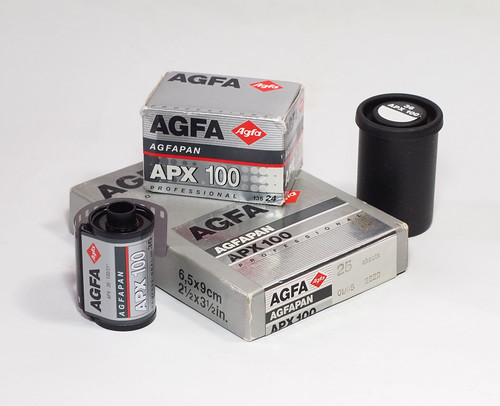 |
| Agfa Agfapan APX 100 in sheet film (6.5x9cm) and 35mm |
With the notion that I might write a blog post about Agfapan APX 100, I sought out a couple of rolls of APX 100 in 35mm to make some tests with - ordinarily, I wouldn't do this for discontinued films, although I might test for sensitivity; a latitude test, and tests for pull/push processing I would usually make for my own future reference, less of a necessity with a discontinued film that one might not have the opportunity to use in future (I also found some 6.5x9cm sheet film around the same time, with a process before date of January 95, using this with my Glunz plate camera, making such a
sensitivity test with one sheet from this box). For a latitude test with the 35mm film, I shot half a roll of Agfapan APX 100 with a date of January 2002, rather older than the Rollei Retro 100 I'd used a few years previously.
 |
| 35mm Agfa Agfapan APX 100 latitude test |
On the contact sheet above the first two rows were rated EI 400/200/100/50/25/12 from left to right; the third and last row was shot at box speed of 100 ISO. This was developed in Ilfotec LC29 diluted 1+19 for 7m30s at 20ºC. Times were taken from the Massive Dev Chart, where Agfapan APX 100 is listed under '
Discontinued/Unlisted' rather than referring to the
data inside the box, which I could have used if I'd developed the film in R09. The results from this test showed that perhaps the film could have benefitted from a little more exposure than box speed, although perhaps not as much as one whole stop; I shot the rest of the first of these two films with the
Kiev-4 rated 80. It is also worth mentioning that Ilfoted LC29 may not have been the best developer for this test, but I didn't have any Rodinal at the time of processing; this may have been better historically, even just in relation to the APX 100 I shot as Rollei Retro 100 a few years ago.
 |
| Agfapan APX 100 (develop before Jan 2002) at box speed |
 |
| Agfapan APX 100 (develop before Jan 2002) rated EI 50 |
When I first used Agfapan APX 100 in its incarnation as Rollei Retro 100, I didn't have much occasion to push the film, shooting just one roll at anything other than box speed: this I rated at an exposure index of 200 as, if I remember rightly, I didn't have any faster films at the time for shooting on an overnight bicycle journey - although I didn't take many pictures during the night itself, more in the early grey dawn hours.
 |
| Agfa Optima Sensor with Rollei Retro 100, rated 200 |
Last year, with the second roll of APX 100 with the develop before date of January 2002, I found myself in a similar situation: taking photographs in a dark interior; with the film already loaded into the Kiev-4, this was not ideal, and I wouldn't normally push expired film this old, especially two stops, but this was a compromise which produced generally acceptable results, with the caveat that there was also some patches of bright sunlight in the otherwise dim building to complicate the exposures, and the density of these highlights rendered noise in the scanning of the negatives.
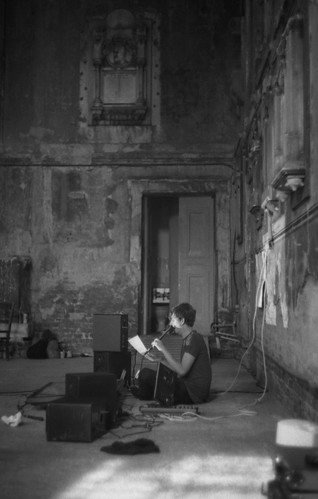 |
| Kiev-4 with Agfapan APX 100, rated 400 |
As I stated in the introduction to this post, this is not a comparison of AgfaPhoto APX 100 with the original Agfapan APX 100: despite the name, these are different films. From what I've read,
Adox Silvermax is close to the original APX 100 emulsion, so a comparison between these two films might have been instructive, and the qualities that I like in Silvermax do seem to be present in APX 100. However, that may not be an entirely equal contest, given that Silvermax is a new film, still very much in production at the time of writing, whereas the most recent stocks of APX 100 would now be coming up to a decade and a half old, and, although, backing paper issues aside, most of the old Agfapan APX 100 I've used has lasted well so far, using existing old stocks of the film such as may still be around must be approached with a little caution - as with any films a fair number of years past their 'develop before' date.
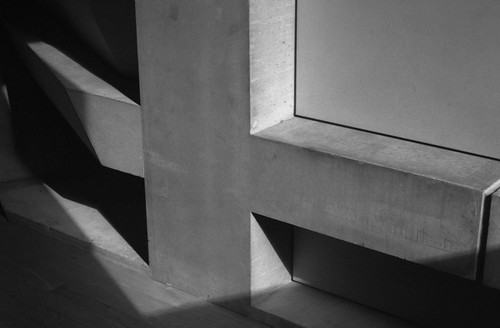 |
| Kiev-4 rangefinder with Agfapan APX 100 (develop before Jan 2002) rated 80 |
 |
| Canon A-1 with Agfapan APX 100 (develop before Jan 2002) rated 100 |
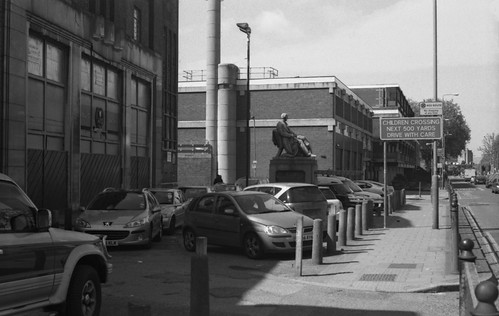 |
| Kodak Retina IIa with Agfapan APX 100 (as Rollei Retro 100) |
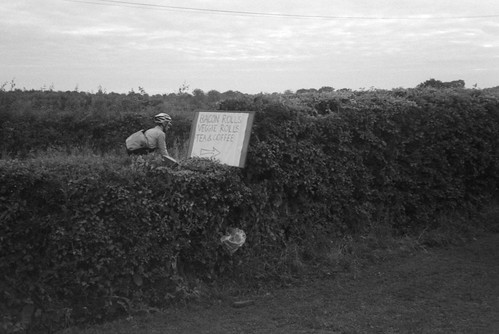 |
| Agfa Optima Sensor with Agfapan APX 100 (as Rollei Retro 100) rated EI 200 |
 |
| Kiev-4 rangefinder with Agfapan APX 100 (develop before Jan 2002) rated EI 400 |
 |
| Baby Ikonta with cut down Agfapan APX 100 (127 format) |
 |
| Zodel Baldalux with Agfapan APX 100 (6x9 medium format) |
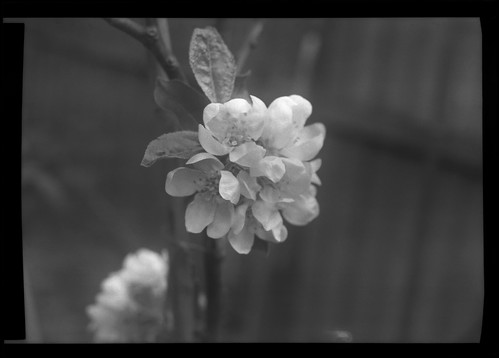 |
| Glunz Mod 0 with Agfapan APX 100 (6.5x9cm sheet film) |
 |
| Kodak Recomar 33 with 9x12cm Agfapan APX 100 |
 |
| Rietzschel Heli-Clack with 9x12cm Agfapan APX 100 |
 |
| Voigtländer Avus with 9x12cm Agfapan APX 100 |






















No comments:
Post a Comment